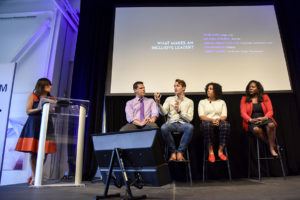Inclusive Leadership: What Gives Employees a Feeling of Belonging?


While corporate culture can set a tone for a workplace, research has found that the experience of individual workers is more influenced by their team leaders. So what makes an inclusive leader, the kind of manager who can give diverse workers a feeling of belonging?
“Authenticity,” said Dionne Wright Poulton, head of diversity at Riverside Community Care. “Authenticity is a precursor to congruity—to make sure your words and deeds are in alignment. If you find you’re making many gaffes [regarding diversity and inclusion], you want to do a self-examination and find out why.”
Poulton was among the speakers on a panel on inclusive leadership at the From Day One conference on Sept. 18 in Boston, where the panelists agreed that one of the most important traits for a leader is humility and being able to say, “I don’t have all the answers.”
Tip-toeing around the issues doesn’t help, asserted KeyAnna Schmiedl, global head of diversity, equity and inclusion at Wayfair, the online home-furnishings retailer. Managers need to move away from strictly being “careful” to really engaging and digging into messy conversations. “I want to sit down and have people engage,” she said.

Boston Globe columnist Shirley Leung, who moderated the panel, asked the speakers to name the No. 1 diversity issue. Tom Bourdon, head of inclusion and diversity at Staples, said “the challenge is to give the adequate time and resources needed to move the needle.” He said that at most companies, “the commitment is there in theory,” but the resources are not necessarily allocated or even available.
Poulton said one of her biggest challenges is, “How to balance the notion that the customer is always right—with protecting the staff?”
This has been increasingly important as Riverside employees find themselves on the receiving end of a growing number of racial slurs and derogatory comments, she said.
“When we realized it was happening across the organization, not a one-off, we wanted to make sure people were being treated fairly,” she said. She credited her organization’s CEO for his willingness to respond quickly to the problem.
Leaders especially need to be open and inclusive when their company is going through change. Tyler Muse, founder and CEO at Lingo Live, found being “radically transparent with people” has helped him best address these issues in his own company, which provides communications coaching. After the company went through a round of layoffs, he said, “the biggest concern for people is psychological safety.”
Lingo Live started as a company teaching language lessons online, but then pivoted more to coaching. As the company made the transition, Muse set up one-on-one meetings with staffers, in which he realized that the employees needed him to fully acknowledge that it was a time of transition for them and the company.
Leung asked the panel what advice they would give to people who have bosses who “don’t get it.”
“If you have someone who isn’t being inclusive, it’s hard to give them the benefit of the doubt—and assume they are clueless—but you really have to,” said Muse. He suggested to try talking to a friend first, if you don’t know how to bring up the topic with your boss.
“If it’s your direct manager, people want to suss out if it’s happening with anyone else,” said Wayfair’s Schmiedl. “Finding out ‘it’s not just me’—is helpful.”
Also helpful, she said, was building in inclusive language when describing a company’s core competencies. “We baked them in—so we are telling you how we expect you to act.”
For example, Schmiedl said instead of requiring employees to be “vocal contributors” at meetings—which could create bias against women and minorities who statistically tend to speak up less—Wayfair changed the term to “proactive contributor” which allowed employees who might be more introverted to contribute via email or other means, not just in the meeting itself.
The panelists agreed that younger workers are more outspoken on social media about their opinions, and more comfortable voicing them at work. As a result, companies need to have a different type of managed conversation about inclusive political and cultural discussions in the workplace.
“I think we millennials crave authenticity more than anything,” said Muse. “Bringing up politics or deeply personal beliefs tells who you are as a leader. There is a risk of doing that, but also of not doing it. I think most people want to know what you stand for—as long as you can explain your personal views are separate from what the organization stands for.”
Schmiedl said millennials, as well as Generation Z, are a group of people who have been shaped by the events they grew up with, like 9/11, so it makes sense they would want to talk about the influence of current events on their lives, but that can bring up divisive topics. The question for businesses is how to create inclusive workplaces that meet their needs, while also addressing the needs of older employees too.
“We can’t be expected to check who we are at the door,” said Poulton. “Organizations should provide a safe space where people can engage in constructive dialogue and are able to talk in a way where, if they disagree, they are not made to feel less than.”

Bourdon agreed that often more harm is done when we don’t say what we think.
Finally, in one of the takeaways from the panel, he suggested, “I think we could move mountains if leaders said three things: ‘How are you doing?,’ ‘How can I support you?,’ and ‘Thank you.’”
In an earlier workshop at the conference, Brittany Hill, CEO of Accelerist, a social-impact partnership technology, led a workshop on “becoming a purpose-driven brand in a sea of purpose-built companies.” She was joined by Gary Lavante, SVP of corporate responsibility at Berkshire Bank.
Jennifer Mattson is a journalist and writer. She is a former producer for CNN and National Public Radio. You can find her work online at The Atlantic, Salon, Psychology Today and USA Today
The From Day One Newsletter is a monthly roundup of articles, features, and editorials on innovative ways for companies to forge stronger relationships with their employees, customers, and communities.